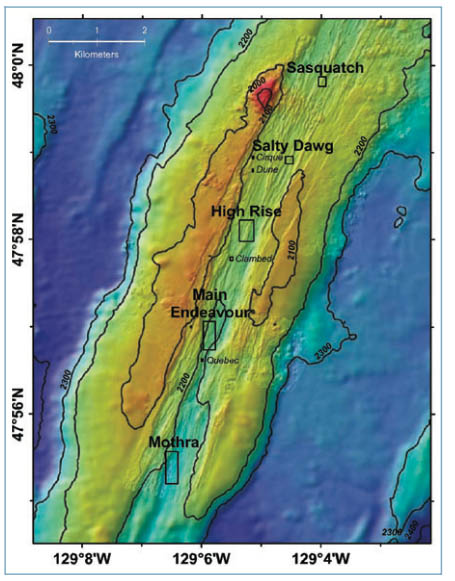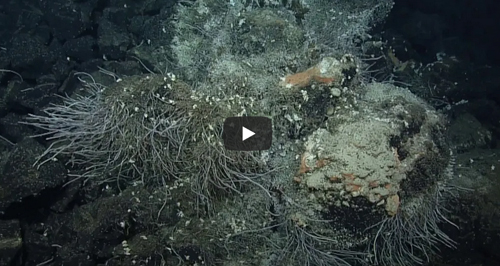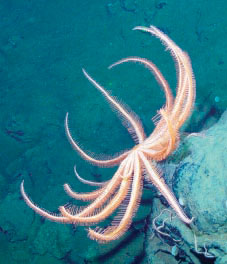Endeavour Hydrothermal Vents Marine Protected Area (MPA)
Note:
Upon the designation of Tang.ɢ̱wan – ḥačxwiqak – Tsig̱is MPA (TḥT MPA) on June 19, 2024 the Endeavour Hydrothermal Vents MPA (EHV MPA) regulations were repealed. This former MPA falls within the larger TḥT MPA and is protected through TḥT MPA regulations.
At-A-Glance
At-A-Glance
Location
Juan de Fuca Ridge, British Columbia; Offshore Pacific Bioregion.
Approximate size (km²) contribution to Marine Conservation Targets
97 km²
Approximate % coverage contribution to Marine Conservation Targets
<0.01%
Date of designation
March, 2003
Conservation Objectives
- Conserve the biological diversity, productivity, structural habitat, and ecosystem function of the hydrothermal vents.
Prohibitions
The Endeavour Hydrothermal Vents MPA Regulations prohibit activities that disturb, damage, destroy or remove from this Area, living marine organisms or any part of their habitat. unless listed as exceptions in the Regulations or approved by the Minister.
Environmental Context
There are five known vent fields on the Endeavour Segment of the Juan de Fuca ridge. Their associated plumes rise rapidly about 300 metres into the overlying water column. Hydrothermal vents in the Endeavour area consist of large hot black smokers, chimney-like structures and surrounding lower temperature sites. The fields span a wide range of hydrothermal venting conditions characterized by different water temperatures and salt content, sulphide structure morphologies, and animal abundance. Temperatures associated with black smokers are typically in excess of 300℃.
Hydrothermal venting systems host one of the highest levels of microbial diversity and animal abundance on earth. In the diffuse vent flows around the sulphide structures, these abundances can range up to half a million animals per square metre. There is an amazing abundance of life in concentrated areas around the vents surrounded by a veritable desert in the deep oceans. There are some 60 distinct species native to the Juan de Fuca Ridge. Many of these species are the first in the world to be identified. Hydrothermal vents at Endeavour are home to 12 species that do not exist anywhere else in the world.

Endeavour Hydrothermal Vents MPA
Dataset for all MPAs available.

Endeavour Hydrothermal Vents MPA
Ecosystem
Ecosystem
The Endeavour Hydrothermal Vents Marine Protected Area (MPA) lies in water 2,250 metres deep, 250 kilometres southwest of Vancouver Island. As part of the Juan de Fuca Ridge system, the Endeavour Segment is an active seafloor-spreading zone where tectonic plates diverge and new oceanic crust is extruded onto the seafloor. In these zones, cold sea water percolates downward through the crust where it is heated by the underlying molten lava, eventually emerging through the seafloor as buoyant plumes of particle-rich, superheated fluid. The five known vent fields on the Endeavour Segment are separated along the ridge from one another by about two kilometres. Their associated plumes rise rapidly about 300 metres into the overlying water column.
Hydrothermal vents in the Endeavour area consist of large hot black smokers, chimney-like structures and surrounding lower temperature sites. The fields span a wide range of hydrothermal venting conditions characterized by different water temperatures and salt content, sulphide structure morphologies, and animal abundance. Temperatures associated with black smokers are typically in excess of 300℃. Formation of the large polymetallic sulphide chimneys takes place when dissolved minerals and metallic ions carried upward by the smokers precipitate upon contact with the cold sea water. Cooler waters below 115℃ on the seafloor and along the flanks of the chimneys support an abundance of flora and fauna. This rich ecosystem is supported by microbes whose life processes are fueled by the chemical energy from the emerging fluids in the hydrothermal vents.
Hydrothermal venting systems host one of the highest levels of microbial diversity and animal abundance on earth. The deep ocean near the Endeavour area normally only supports sparse animal abundance of about twenty worms and brittlestars per square metre. In the diffuse vent flows around the sulphide structures, these abundances can range up to half a million animals per square metre. There is an amazing abundance of life in concentrated areas around the vents surrounded by a veritable desert in the deep oceans.
Globally, hydrothermal venting systems foster numerous unique species of animals. There are some 60 distinct species native to the Juan de Fuca Ridge. Many of these species are the first in the world to be identified. Hydrothermal vents at Endeavour are home to 12 species that do not exist anywhere else in the world.
Since its discovery in 1982, the Endeavour Hydrothermal Vents have been a focus of research by Canadian and international scientists. The manned US submersible Alvin and the unmanned vehicle Jason have undertaken a number of missions in the area. Joint Canada-US studies have made use of the Canadian ROPOS (Remotely Operated Platform for Ocean Sciences). Fisheries and Oceans Canada has conducted extensive acoustic and moored instrument programs in the area since 1985.
The Endeavour Hydrothermal Vents Marine Protected Area has been designated to ensure the protection of these hydrothermal vents, and the unique ecosystems associated with them. The Regulation to establish the Marine Protected Area prohibits the removal, disturbance, damage or destruction of the venting structures or the marine organisms associated with them. The Regulation allows for scientific research that will contribute to the understanding of the hydrothermal vents ecosystem.
Management & Conservation
Management & Conservation
The Endeavour Hydrothermal Vents (EHV) were designated as the first Marine Protected Area under Canada's Oceans Act in 2003. The designation of the Endeavour Hydrothermal Vents as a MPA provides for the long-term protection of this biologically diverse and productive ecosystem.
The MPA management:
- ensures that human activities contribute to the conservation, protection and understanding of the natural diversity, productivity and dynamism of the ecosystem
- ensures that responsible procedures are followed (e.g. sampling, instrument deployment and retrieval, data sharing, appropriate debris disposal).
- provides research for the conservation, protection and understanding of the area.
- contributes to public awareness of the values of marine ecosystems and the need to protect them.
The area has been a popular research site for more than 20 years. Scientists come to study unique biota, venting processes and chemistry, as well as seismic and magmatic activity. An organism from this site holds the current record for the upper temperature limit to life: 121℃. Researchers strive to uncover secrets of the formation of Earth's tectonic plates and chemosynthetic food webs. They also seek a potential glimpse of the origins of life on our planet, and perhaps its origins on others.
- Endeavour hydrothermal vents: marine protected area management plan 2010-2015
- Endeavour hydrothermal vents Marine Protected Area regulations (SOR/2003-87)
- Regulatory Impact Analysis Statement
- Marine Protected Area Endeavour Hydrothermal Vents map
- Endeavour Hydrothermal Vents Marine Protected Area (MPA) annual report 2023
Activity Application
Activity application for Endeavour Hydrothermal Vents MPA
Scientific research is allowed in the Endeavour Hydrothermal Vents MPA if a proponent submits a research plan to the Department of Fisheries and Oceans (DFO) for Ministerial approval.
Note:
A research plan is not required if the information has been previously submitted to Global Affairs Canada to obtain a consent to conduct scientific research under the Coasting Trade Act.
- Date modified:



